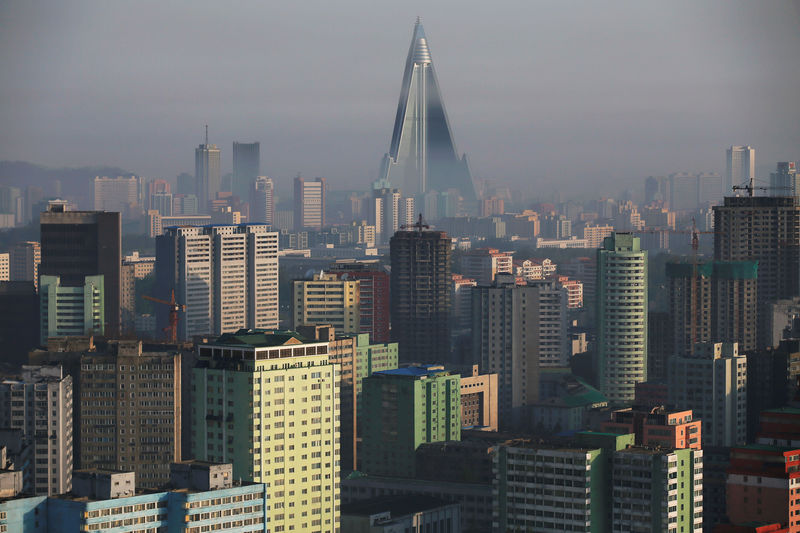(Bloomberg) -- Three destructive typhoons, U.S.-backed sanctions and the global pandemic are fueling concern that North Korea’s 26 million people could slip back into the devastating food shortages the country faced during the rule of Kim Jong Un’s father in the 1990s.
Kim said the country is under “an intensive struggle” to recover from the floods and typhoons, according to the official Korean Central News Agency. Kim has been shown repeatedly exhorting officials to minimize the damage to crops and boost yields.
“How many people have endured and struggled with the difficult environment this year?” Kim said, appearing to cry in his speech during a massive military parade on Oct. 10. “The patriotic devotion of our People’s Army soldiers on the quarantine front and in natural disaster recovery front cannot be treated without tears of gratitude.”
A trio of major storms hit the country in just two weeks in August and September, just before the main annual harvests, disrupting food supplies in a nation where the United Nations World Food Program estimates some 40% of the population is already undernourished. The devestation follows a poor harvest last year and disruption to food imports from China and elsewhere due to the coronavirus.
“People are reportedly selling their assets and furniture, taking loans, and going to the mountains to find medicinal herbs, forage for food and cultivate small patches of land to survive,” the UN’s Special Rapporteur on North Korean human rights wrote in an advance copy of a report to the General Assembly this week.
Border closures due to Covid that reduced imports of agricultural inputs such as fuel and fertilizer during planting earlier this year could lead to this year’s harvest being the smallest since 1994, the report said.
While extreme weather events have disrupted farming around the world, North Korea is especially vulnerable. A mountainous country, only 22% of its land is suitable for crops, according to the UN Food and Agriculture Organization. The nation’s isolation from global trade have also left it perennially dependent on food aid, mostly from China. Floods and droughts in the 1990s led to a famine that killed as much as 10% of the population.
“North Korea’s dependence on rain-fed agriculture, limited high-quality arable land, low mechanization of the farming sector and challenges with importing agricultural inputs such as fertilizers, combine to make the country vulnerable to climatic shocks,” Kun Li, UN World Food Program spokeswoman for Asia and the Pacific, said in an interview.
Despite improvements in North Korea’s farm output over the past few decades, the country is still in the bottom quarter of the Global Hunger Index, and in the top quarter of the Index for Risk Management in terms of disaster risk. Floods and drought regularly strike North Korea in the same year, contributing to a perennial annual deficit of about 1 million tons of food, according to FAO estimates.
In the summer of 2018, temperatures rose as much as 11 degrees Celsius above average, followed by a typhoon and floods in August, destroying more than 17,000 hectares (42,000 acres) of crops, according to a report by the UN Office for the Coordination of Humanitarian Affairs. The same year, the economy shrank by the most since 1997. Fitch Solutions expects the same level of contraction this year as the pandemic led to border closures and flooding destroyed swathes of crops.
State media organization KCNA said average summer precipitation this year was the second highest in the past 25 years. Reports in February and April alluded to “abnormal climatic phenomena” due to global warming. South Korea’s weather office predicted average temperatures in its northern neighbor will be 15% higher over the next 20 years than in the three decades to 2010.
North Korea’s climate risk has been made worse by decades of deforestation. Starting in the 1970s, people cut down trees to clear hillsides for farming, said Myeong Soojeong, a chief research fellow at Korea Envoronment Institute. Almost 900,000 hectares of forest have been lost over the past three decades, according to the FAO.
That makes the nation more vulnerable both to higher temperatures and flooding bacause of the lack of trees to soak up excess rainwater, said Kong Woo-seok, a geography professor at Kyung Hee University in Seoul.
“It’s a vicious cycle,” Kong said. “Global warming accelerates the frequency and intensity of extreme weather events, for which North Korea is particularly vulnerable due to its isolated economy and lack of social infrastructure.”
©2020 Bloomberg L.P.
